

Advance Your Education With Free College Courses Online - Udacity. How To Use Bloom’s Taxonomy To Write Learning Outcomes. By: Scott Davis Business Analyst, Pearson It is often quite difficult to relate inputs to outcomes in the world of education.

Traditionally, much work has been done to develop and provide inputs into the process of education. These inputs, such as a textbook, an assessment, a learning technology or platform, a course, a qualification, a high-stakes test or professional development for teachers are put into the hands of an educational leader, a skillful teacher, or an eager student. And, for all of the investment, expertise, and care that go into their creation, that has typically been where the involvement ends. Rarely has one been able to measure or predict the learning outcomes from using these inputs. If we are going to really understand how we might be impacting student learning we must do two things. Everything You Need To Know In Google Classroom (Part 3) This is part three of a three part guide.
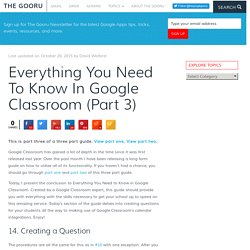
View part one. View part two. Google Classroom has gained a lot of depth in the time since it was first released last year. Over the past month I have been releasing a long form guide on how to utilize all of its functionality. Everything You Need To Know In Google Classroom (Part 2) This is part 2 of a three part guide.
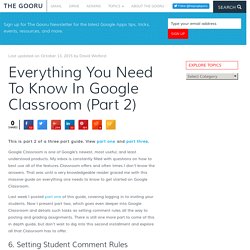
View part one and part three. Google Classroom is one of Google’s newest, most useful, and least understood products. My inbox is constantly filled with questions on how to best use all of the features Classroom offers and often times I don’t know the answers. That was until a very knowledgeable reader graced me with this massive guide on everything one needs to know to get started on Google Classroom.
Last week I posted part one of this guide, covering logging in to inviting your students. 6. If you just invited students to your class you should still be in this student screen. When you click on that it will give you three options. Everything You Need To Know In Google Classroom (Part 1) I get lots of emails asking about Google Classroom.
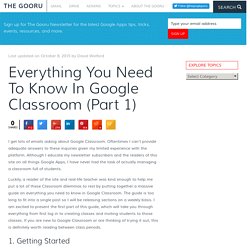
Oftentimes I can’t provide adequate answers to these inquiries given my limited experience with the platform. Although I educate my newsletter subscribers and the readers of this site on all things Google Apps, I have never had the task of actually managing a classroom full of students. Luckily, a reader of the site and real-life teacher was kind enough to help me put a lot of these Classroom dilemmas to rest by putting together a massive guide on everything you need to know in Google Classroom.
The guide is too long to fit into a single post so I will be releasing sections on a weekly basis. For Education: Google Classroom: Basics. Students have an entirely different view of Classroom than teachers.
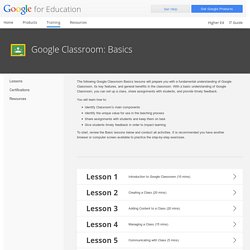
But it is equally as easy to use. Students can join classes, communicate with their teachers, turn in assignments, and even revise work that has already been turned in. Online Learning Resources. The Question Matrix by. This is a blog about questioning students in lessons.
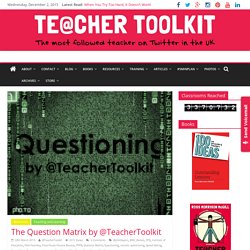
“Have you ever had a dream, Neo, that you were so sure was real? What if you were unable to wake from that dream? How would you know the difference between the dream world and the real world?” Morpheus – The Matrix Film – 1999 A couple of years ago, I first blogged about Pose, Pause, Pounce, Bounce! In my adaptation of PPPB, I added my own twist to teacher-questioning, by introducing the characters from Winnie The Pooh. My resource can be downloaded below. Full Circle: As a result of sharing my interpretation of PPPB, geography teacher @JohnSayers then wrote this blog; Asking Questions and tweaked the resource into this useful matrix. . • to clarify • to challenge assumption • to evidence for argument • to gather viewpoints and perspectives • to predict implications and consequences • to question the question. On-the-Spot Support: Using the Scaffolding Technique in Your Teaching Approach.
When you think about scaffolds, you probably visualize the structures used during construction to support workers and materials.
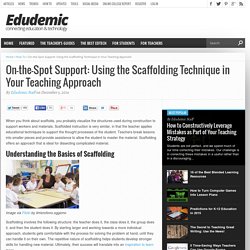
Scaffolded instruction is very similar, in that the teacher applies educational techniques to support the thought processes of the student. Teachers break lessons into smaller pieces and provide assistance to allow the student to master the material. Scaffolding offers an approach that is ideal for dissecting complicated material.
Understanding the Basics of Scaffolding Image via Flickr by ilmicrofono.oggiono Scaffolding involves the following structure: the teacher does it, the class does it, the group does it, and then the student does it. The Difference Between Pedagogy, Andragogy, And Heutagogy. The Difference Between Pedagogy, Andragogy, And Heutagogy by Terry Heick Jackie Gerstein’s passionate thinking about learning is some of my favorite to read.
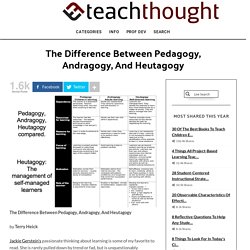
She is rarely pulled down by trend or fad, but is unquestionably progressive and forward-thinking in her approaches to learning and thinking about learning. She and I also share a passion: self-directed learning. (As does the original summarizer/author of the thinking embedded in table above, Lindy McKeown Orwin.) I’m embarrassingly interested in any kind of learning at all–formal or informal, self-directed or teacher-centered, authentic or academic. Gerstein’s presentation, “Education 3.0 and the Pedagogy of Mobile Learning” uses the concept of mobile learning as a spearhead into a broader discussion of how people learn–different approaches, different domains, and different technologies.
Summaries of Learning Theories and Models.